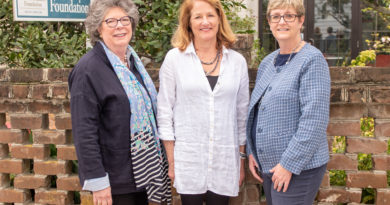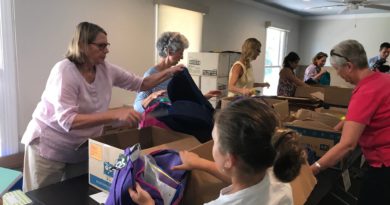Daughters of the Dust
story by mary ellen thompson photography by john wollwerth
Daughters of the Dust will screen at 7:30 p.m. at BIFF on Saturday, February 19. Twenty five years ago, this film was the first feature directed by an African American woman to receive general theatrical release and writer and director, Julie Dash, will be here to receive an award at the Awards Ceremony on Sunday evening, February 20.
This film was made here in 1989 and the following members of the community who were associated with the film are very excited about the fact that it was restored and will be shown again at BIFF. They share their memories and associations with the film.
Kai-Lynne Warren: Actress
Kai Lynne portrayed the character of the Unborn Child in the film (although her voice was dubbed over). Her grandmother, Jesse Mae Warren, was working at the Penn Center and heard about the movie, so Kai-Lynne’s mother brought her to the casting call and Kai-Lynne was chosen. When asked what she remembers about being in the film, she initially replies, “Not so much, I was only seven. I remember running and playing on the beach. I do remember that I appreciated acting after that, I had seen what it took to film a scene.” Did she pursue an acting career as a result? “No; I auditioned for Queen in Charleston but didn’t get a part and there wasn’t anything else.”
How did Kai-Lynne find out that Daughters of the Dust had been re-released? “My mother saw it on facebook!”
When questioned about the last time she saw the film, Kai-Lynne says, “It was on television some years back. I was talking to a co-worker and she was telling me that she saw a movie on television and thought a little girl in the film looked just like me. I asked her what movie it was and when she said Daughters of the Dust, I told her – that was me!”
“Oh,” Kai-Lynne said, “there is one other thing I remember. I was constantly having to get my dress fixed. I kept getting holes and tears in it, the fabric was so thin and I was running around playing on the beach and climbing trees.”
Kai-Lynne is looking forward to attending the film at BIFF with her husband who has never seen it. “It was a wonderful film and everyone who was part of it was so nice.”
Willie Faulkner: Actor
Willie had a speaking part in 23 films that were filmed in this area, in this one he played Peazant Man #1. Of Daughters of the Dust, he recalls, “It was different than the other films I had worked on; there was more feeling. The Black culture was and still is trying to be equal, to overcome obstacles. Julie Dash was wonderful to work for. I had a speaking part as Peazant Man #1. I had to be on the set every day, and I still remember that when we were shooting out at Hunting Island, those sand gnats were trouble.”
When asked what about being part of that experience still sticks with him after 27 years, Willie explains, “All of it still sticks. Daughters of the Dust mirrored our times then and mirrors our time now. As in the film, we were leaving the old world and coming to the new. There were many people here who left to go to New York and then wanted to come back. In the film and life, there were the old ladies, the grandmothers in the old world, who would say, ‘You go on, I’ll stay here. Or they would give their children protective things so they would be safe and remember their roots. The film points up and points out the flaws and attributes of these times, then and now.” Willie has the original script of the film.
Ervena Faulkner: Extra
“It was great fun, I was just an extra in four or five scenes but not all the scenes I was in were used in the movie. I called being on the set ‘hurry up and wait’ time. But I did get in the film in the baptismal scene where everyone was going down to the water. I know my hips and when I saw the movie I could see them! Ron Daise was also in that scene so we both got in the film.”
“We went to the screening in Atlanta. When Julie Dash’s book came out in 1992, I read it with my book club.”
Mary Mac: Hostess
“I had The Red Piano Too Art Gallery on Saint Helena. At that time it was where MacDonald Marketplace is now and was across the street from E’s Fabric Shop, which was owned by Edith Sumpter. One day when I was in the shop I saw Vertamae Grosvenor, who I recognized from ETV and NPR, and I had read her books. So I chatted her up and found that she was shopping for fabric for the costumes for Daughters of the Dust. My husband, Tommy, had a small side business doing tailoring so I invited them to the house to meet him. He wound up making some of the costumes and repurposing an umbrella that was carried by the character, Yellow Mary, in the film. I invited the cast to dinner and they all came.”
When asked what she remembers now about that dinner, Mary replied, “I put bacon in the gumbo and they didn’t like it; most of them were vegetarians. Luckily I also had salad, rice and cornbread so that was what they ate. I remember putting a bottle of soy sauce on the table,” Mary laughs. “They were excited about the area, the history and culture. I was excited about the fact they were making a movie here.”
Why does she think the film is important? “It’s a slice of life. See if you can put yourself in that role. You don’t have to stay there, but see what it’s like.
“When the film was released, as part of the Ladies of the Lowcountry, in conjunction with the Penn Center, we held a fundraiser for Penn and the film was screened at the theater at the Marine Corps Air Station (MCAS). The theater was filled.”
Diane Britton Dunham: Artist
What impressed Diane most about the film was, “The cinematography, the flowing white gowns, the scenery; the location is like a character in itself. The music was ethereal and mesmerizing; I just loved the beauty of it. When people saw the film they really began to understand the culture of the Gullah people; Julie Dash covered so many of the images like net making, basket weaving and the bottle trees. Daughters of the Dust is a cult classic.”
Diane has said that the film had an influence on her art, that many of her paintings have the spirit of the character the Unborn Child. She explains, “I can relate to her as the little girl in my self. She is mystical because she ties the story together; most of my paintings have a little girl in them, some of them are her spirit and some of them are me.”
When asked what her involvement with the making of the film was, Diane replies, “None. Except that Mary Mack wanted me to do a painting that might be used for the movie poster.” Diane did the painting and although it didn’t make it as a movie poster, it did grace the cover of the pamphlet that was used for the film screening at MCAS. She was, however, caught up in the conviviality of picture making. “I was living on Saint Helena and the cast and crew were in the center of the Frogmore Community; they stayed in the motel there and went to the shops. Mary was managing my art and it was in her gallery there so I had the opportunity to watch from the sidelines. I loved the energy of the artsy community. I always wanted to be an artist and hang out in that kind of community. I had just started exhibiting so I was new to this art world and I was shy so I just watched the goings on whenever I could.”
Jacquelyn Markham: Associate Professor
When asked how she first became aware of the film, Jackie remembers, “During the time Julie Dash was filming Daughters of the Dust, she was living in Atlanta and I was teaching Women’s Studies at the University of Georgia. In a course on women’s contributions to culture, we studied some film directors working at the time and I believe Julie Dash’s name surfaced. Shortly after, I viewed the film.”
Jackie recounts her initial impression of the film, “I fell in love with it! When I was in graduate school, I majored in literature and poetry, but I took every film course I could and even considered a minor in film. Also, I have a great love of visual art. To me, Daughters of the Dust is like an impressionist painting coming to life with the mystery of poetry.”
As a teacher, what made Jackie want to incorporate the film into her teaching, and how has she done so? “I came to the film from so many angles: literary, artistic, cultural, and this film has the potential to open so many dialogues and explorations. I think that is why it has been my favorite film for 25 years and why I wanted to incorporate it into my teaching. I like to use film in my literature courses in general because so many students relate to the visual and there are always parallel points in film and literature that students can discuss and write about. In Daughters of the Dust, we could talk about the nonlinear narrative, symbolism, the mystery or poetic sense of the film as well as the social, historical, and cultural implications.”
The film has stayed with Jackie, and she describes that for us. “This film has made a lasting impression on me in ways I would never have imagined when I was first introduced to it. I had no idea at that time that I would even leave Athens, Georgia or that one day, my interest in culture would entice me to know more about the Gullah culture and an eventual move to the Beaufort area. I first visited St. Helena and Penn Center in 2002 and Daughters of the Dust came alive again. I can’t tell you how many people I have told about this amazing film. Now that it has been restored and is getting the recognition it deserves, I feel privileged to again see it on the big screen at BIFF and hopefully see and hear Julie Dash tell us more about her vision and current projects.”
Epilogue from the original script: “Just as streams coalesce into rivers, and rivers coalesce into oceans, these black freedpeople entered the larger body of the black experience – remembering, recollecting, and recalling the daughters of the dust.”




